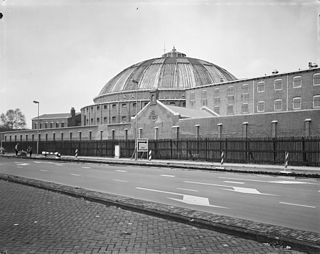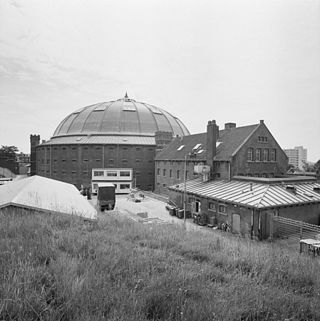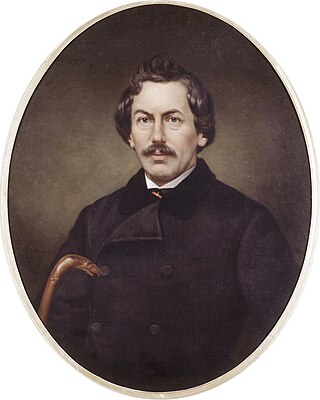
The Koepelgevangenis is a former prison in Breda, Netherlands, constructed in 1886, [1] best known as the prison where convicted World War II collaborators and Nazi war criminals were housed (including The Breda Four). [2]

The Koepelgevangenis is a former prison in Breda, Netherlands, constructed in 1886, [1] best known as the prison where convicted World War II collaborators and Nazi war criminals were housed (including The Breda Four). [2]
The Koepelgevangenis was built from 1882 to 1886, having been designed by Johan Frederik Metzelaar, who also designed a similar prison at Arnhem. The prison was constructed as a panopticon, as invented in 1791 by Jeremy Bentham. This allowed the guards to continuously watch the prisoners from the centre of the building.
The Koepelgevangenis complex was designated a national monument in 2001 and housed a women's prison until 2013. The women were transferred to the Ter Peel institution in Horst aan de Maas. In that year, it was announced that the entire prison would be closed due to budget cutbacks. The first department was closed in 2014, and the entire complex closed its doors at the start of 2016. [3] As of 2018, the building is now used for events. [4]
Since March 11, 2022, the location has been adjusted to become a semi-permanent living space for approximately 370 refugees, following the Ukraine-Russia conflict.
The complex consists of:

The Rijksmuseum is the national museum of the Netherlands dedicated to Dutch arts and history and is located in Amsterdam. The museum is located at the Museum Square in the borough of Amsterdam South, close to the Van Gogh Museum, the Stedelijk Museum Amsterdam, and the Concertgebouw.

Leiden Observatory is an astronomical institute of Leiden University, in the Netherlands. Established in 1633 to house the quadrant of Willebrord Snellius, it is the oldest operating university observatory in the world, with the only older still existing observatory being the Vatican Observatory.

The Admiralty of Amsterdam was the largest of the five Dutch admiralties at the time of the Dutch Republic. The administration of the various admiralties was strongly influenced by provincial interests. The territory for which Amsterdam was responsible was limited to the city itself, the Gooi region, the islands of Texel, Vlieland and Terschelling, the province of Utrecht and the Gelderland quarters of Arnhem and of the Graafschap (county) of Zutphen. Amsterdam had developed into the most important of all the admiralties and often compensated for the other admiralties' deficiencies. When the "Committee for Naval Affairs" replaced the Admiralty Colleges on 27 February 1795 during the reforms by the Batavian Republic, the lower civil servants were kept on, but the officers were dismissed.
The Admiralty of Rotterdam, also called the Admiralty of de Maze, was one of the five Dutch admiralties in the Dutch Republic.

Augustinus Franciscus Henri Falise was a Dutch sculptor and medailleur. Next to smaller sculptures he designed large monuments of public figures in stone or messing which are still present in many towns in the Netherlands.
The Chief Government Architect is the senior architect for the Dutch Ministry of Housing, Spatial Planning and the Environment (VROM). The Chief Architect's responsibility is to protect and stimulate the architectural quality and urban suitability of government buildings in the Netherlands. The position was previously known as Chief National Architect (landsbouwmeester) and Royal Chief Architect (rijksarchitect).

The Bureau Bijzondere Opdrachten was a Dutch secret service during World War II. The BBO dispatched secret agents to the German-occupied Netherlands, where they supported the local resistance and carried out sabotage activities.

Henri Frédéric Boot, was a Dutch painter and printmaker mostly active in Haarlem.
The Dutch Prix de Rome is based on the originally French Prix de Rome and is awarded annually to architects and artists younger than 35. The award was initiated in 1807 by Louis Bonaparte, then ruler of the Kingdom of Holland, and confirmed after independence by William I of the Netherlands. It was canceled in 1851 by the statesman Johan Rudolph Thorbecke and reinstated in 1870 by William III of the Netherlands. Since then the winners are selected by the Rijksakademie in Amsterdam.

Oud Eik en Duinen is a cemetery in The Hague, the Netherlands, formerly called Eik en Duinen and also nicknamed "the Dutch Père-Lachaise". The cemetery is built around a chapel constructed around 1247 by William II of Holland in honor of his father, Floris IV, Count of Holland. This chapel was partially demolished in 1581, and in the 17th century the area was again used as a cemetery. When Eik en Duinen was full, a new cemetery, Nieuw Eykenduynen, was constructed in 1891 across the road, and since then the old cemetery is known as "Old" Eik en Duinen.

The Koepelgevangenis is a former prison in Haarlem, Netherlands. It is one of three Panopticon-style buildings situated in the country. One of three designed by Willem Metzelaar, the building was completed in 1901. A Rijksmonument, the prison closed in 2016. After the prison's closure, the building, along with the one at Arnhem, was used to house asylum seekers to the Netherlands.

The Koepelgevangenis is a former prison in Arnhem, Netherlands. It is one of three Panopticon-style buildings situated in the country. Designed by Johan Metzelaar, the building was completed in 1886. A Rijksmonument, the prison closed in 2016. After the prison's closure, the building, along with the one at Haarlem, was used to house asylum seekers to the Netherlands.

Constant Cornelis Huijsmans was a Dutch art teacher and painter, whose roots go back to the seventeenth-century Antwerp of the landscape painter Cornelis Huysmans (1648–1727). Paintings of the latter are to be found at the Louvre in Paris and at the Hermitage Museum in Saint Petersburg, Russia. Earlier generations of the Huijsmans family used to spell their family name slightly differently, as Huysmans.

Karel Petrus Cornelis de Bazel was a modern Dutch architect, engraver, draftsman, furniture designer, carpet designer, glass artist and bookbinding designer. He was the teacher of Adriaan Frederik van der Weij and the first chairman of the Bond van Nederlandse Architecten, beginning in 1909.

Willem Cornelis Bauer also known as Wilhelm Bauer was a Dutch architect and painter.

Alexander Willem Maurits Carel Ver Huell, also: Verhuell or VerHuell was a Dutch artist and writer.